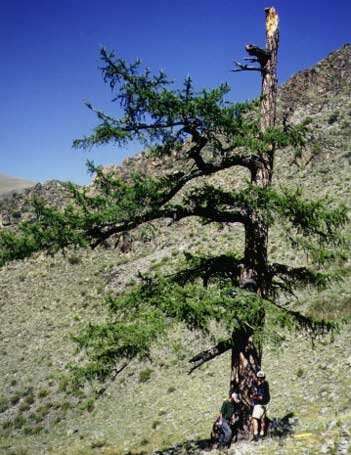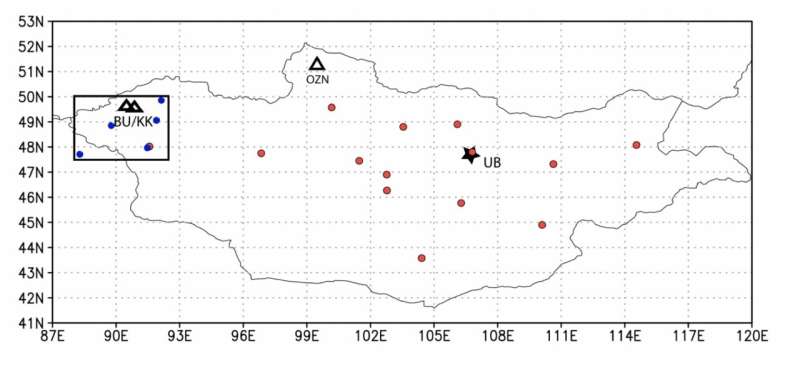New way of analyzing tree rings confirms unprecedented central Asia warming

A relatively new way of analyzing tree rings has allowed researchers to reconstruct temperatures in Mongolia since 1269 C.E. The new reconstruction confirms that since the 1990s, summer temperatures are the warmest the region has seen in the past eight centuries.
Published in Geophysical Research Letters, the study is led by Nicole Davi, an adjunct senior research scientist at Columbia University's Lamont-Doherty Earth Observatory.
Central Asia is one of the fastest-warming places on the planet. In just the past 15 years, summer temperatures have warmed 1.59 degrees C, or nearly 3 degrees F—almost three times the global average rate. During the same period, the region has suffered through extreme and extended droughts.
To date, there are only a handful of long-term climate records in central Asia that can help to put these trends into context. Analyzing the rings from trees can tell scientists about temperature and precipitation patterns hundreds or thousands of years in the past, but suitably old trees and logs in this region can be difficult to sample, in part due to their remoteness.
The scarcity of tree ring data in the region makes the new reconstruction all the more important. To create it, Davi and her colleagues analyzed tree ring cores that were originally collected in 1998 and 2005 for a project led by her mentor, Gordon Jacoby, co-founder of the Tree Ring Lab at Lamont. Jacoby had been trying to reconstruct the region's temperature history using ring widths, but the data wasn't strong enough, so he set it aside. Before Jacoby died in 2014, Davi asked permission to take over the project.
The samples come from several high-elevation forests in western Mongolia. "People think of it as this vast steppe system, but there are some remarkable old forests throughout the country and it's very pristine," said Davi. The locations were very remote, she added. "It is quite an expedition to get to these forests."
The cores come from a combination of living Siberian larch trees dating back 400 to 500 years, and relict wood—ancient trees that had fallen over but hadn't decayed, thanks to the cold and dry conditions. "When we find relict wood it's super exciting because we know we can go back further in time," said Davi.

She wanted to put the samples to good use, and since the ring-width model hadn't panned out, the team decided to try a different way of analyzing them: Measuring the density of the wood. This is done by taking an extremely thin sliver of the tree core—thinner than a human hair—and shining light through it. More light will penetrate through less dense rings, and less dense rings indicate colder growing conditions. Davi and her team tried this method, but unfortunately, she said, "It's expensive, it takes a lot of time, and it's pretty destructive. It would break up the core, and we couldn't get what we needed."
Finally, the team turned to a newer method that came into use a few years ago and has shown promising results. Called delta blue intensity, the method looks at how well each ring reflects blue light in its latewood (the darker band that forms later in the growing season) compared to in the lighter early wood. Less dense wood that results from cooler conditions absorbs less blue light.
The stronger results from the delta blue light technique allowed the team to build a model of summer temperatures in the region from 1269 to 2004 C.E. The reconstruction matches up well with data from regional weather stations dating back to the 1950s, as well as cooling events associated with several large-scale volcanic eruptions.
For Davi, publishing these findings feels personally meaningful. "Gordon Jacoby was my Ph.D. advisor, mentor, and friend," she said. "We had a lot of adventures doing fieldwork together. Bringing closure to some of the research that he started definitely feels good."
The findings support the growing potential of the delta blue intensity method to improve our understanding of past climates, said Davi. They also put central Asia's warming into context, and enhance projections, under which the region is expected to warm by another 3 to 6 degrees C (5.4 to 10.8 F) by the end of the century. The rapid warming is already harming fragile ecosystems and causing devastating livestock losses for pastoralists, who traditionally have formed the backbone of the Mongolian economy.
"What does it mean for livelihoods in Mongolia?" asks Davi. "This is a largely agrarian culture. Some people live in cities, but there are also people who are nomadic herders who have been living the same way for thousands of years. This reconstruction certainly adds context to the warming of the past several decades, and to global climate models showing what it could look like in the future."
The paper recommends continued investment in infrastructure and climate resilience programs such as index-based livestock insurance to help communities cope with the changing conditions.
More information: N. K. Davi et al, Accelerated Recent Warming and Temperature Variability Over the Past Eight Centuries in the Central Asian Altai From Blue Intensity in Tree Rings, Geophysical Research Letters (2021). DOI: 10.1029/2021GL092933
Journal information: Geophysical Research Letters
Provided by Earth Institute at Columbia University





















